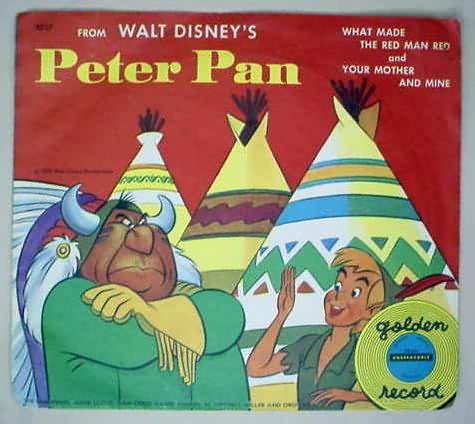Purdy make a lot of good points in his analysis of the movie. For instance, when John and Michael Darling go "huntin'" Indians, Purdy writes:
As they march, various animals, ones often seen as threats in the "wild," intervene without slowing their progress ... and this comic intervention and the animated landscape in which transpires act to deflect the problematical nature of the history inherent in the action itself and the soundtrack's patriotic message. The colonial history of the continent is reduced to a picnic in the garden and, for a young boomer audience uninformed of the specific details of that history, a game.
What follows is an extended allusion to Disney's predecessors and the text's antecedents as the boys are bound and taken to the Indian encampment where they are tied to the stake (teddy bear included). ... The image was/is pervasive despite its questionable accuracy burning at the stake was as much a European tradition as an indigenous one. Nonetheless, for the boomer audience, the imaginative evocation of this horrific type of death was frighteningly powerful, particularly with the soundtrack providing yet another Hollywood convention: cue pounding "war" drum.
Peter returns Tiger Lily to her father and is immediately adopted into the tribe as a "Big Chief" named Flying Eagle." The Chief passes around the peace pipe and offers to teach Peter and his crew "all about red man." The crew asks three questions: "What makes the red man red?" "When did he first say,'Ugh'?" And "why does he ask you, 'How'?" The questions reveal the limited scope of understanding for the characters and audience alike, they operate on assumptions about the behavior and biology articulated in US literature, and they provide the comical and problematical lyrics for the song that is sung next.
All in all, the various motifs should be immediately recognizable, particularly for a boomer audience. From the story of John Smith and Pocahontas (yet another Disney story in recent years for the boomers' children and grandchildren) to Dances with Wolves, the plot and its implications are pervasive. The white guy saved the maiden, effortlessly enters the "Indian culture" where he is immediately a hero and a leader, then leaves the tribe to its "inevitable" fate as he returns to the world of modernity and power. Although the individual hero and his partner benefit from the exchange, no one else does.
I'd say his analysis of the book complements my analysis of the original text. Together they explain how Peter Pan is racist.
Unfortunately, Purdy's article isn't online. You'd have to buy the issue of Western American Literature, or go to an academic library, to see it.
For more on the subject, see The Best Indian Movies.


No comments:
Post a Comment